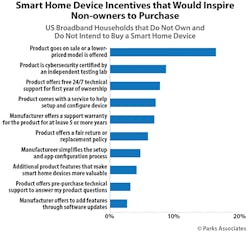Latest from Network Transformation/Edge Compute/IoT/URLLC/Automation/M2M
Breaking Smart Home Barriers
Why Consumers Don’t Buy —
New research from Parks Associates reveals that among the 42% of US broadband households who do not own and do not plan to buy a smart home device, 17% indicate they would likely buy a device if the cost were lower. (See Figure 1.)
Figure 1.
Capturing these consumers at the right price point would add 7.9 million more households to the population of smart homeowners.
The report, Breaking Smart Home Barriers: Why Consumers Don’t Buy, addresses market barriers and mines consumer fears and presents strategies for addressing or alleviating their concerns in order to expand sales.
Price is a major barrier to smart home adoption, especially among younger heads of household, who recognize the value but feel priced out of the market. Reducing price while still offering important features is a valuable strategy, with WYZE and Yi Home taking this route. Nest, eufy, and Blink have all released lower-priced versions of their products that include fewer features at a more affordable price.
Discounting product prices and bundling products in ways that strengthen value are critical strategies to attract the majority of consumers who rank affordability in their top 3 purchase considerations. Bundling of smart home devices such as smart plugs, smart light bulbs, or smart thermostats with a smart speaker, can introduce the smart home experience to consumers through a leading entertainment device that can be used to stream music and control smart home functions.
More than 50% of US broadband households who do not own or intend to purchase a smart home device report they do not see any benefits to smart home ownership, although this attitude is more prevalent among older consumers.
InvisiLight® Solution for Deploying Fiber
April 2, 2022Go to Market Faster. Speed up Network Deployment
April 2, 2022Episode 10: Fiber Optic Closure Specs Explained…
April 1, 2022Food for Thought from Our 2022 ICT Visionaries
April 1, 2022Messaging that highlights strong product value helps overcome price sensitivity and counters the perceived lack of a viable value proposition. Familiarity with devices is increasing, but value perception is not. Brands must emphasize pragmatic value propositions such as energy savings, loss prevention, and safety, to persuade the broad swatch of broadband households that do not see any benefit or value in owning smart home devices.
Additional data highlights of the research include:
- 43% of US broadband households that do not own or intend to own a smart home device find that smart home devices are too expensive.
- 34% of US broadband households own at least 1 smart home device, based on a comprehensive list tested in Parks Associates’ surveys.
- 33% of US broadband households that do not own or intend to own a smart home device have privacy and security concerns.
Following the plethora of smart home announcements showcased at CES earlier this year, the smart home space continues to see a lot of activity in the first half of 2021, particularly in product and user-interface innovation.
Amazon, in particular, announced new products, added new features to existing devices, and continued its efforts to expand product capabilities and provide additional value and features for its Ring and Echo users.
- Ring introduced a trio of outdoor smart home security devices. The new outdoor siren and wall lights are consistent with Ring’s home security strategy, which is centered on crime deterrence.
- Ring also debuted a new $60 video doorbell, the company’s cheapest video doorbell yet. With lower-priced products becoming increasingly available in the competitive smart home market, Ring is also taking measures to improve the value of its existing products.
- The company introduced a Smart Responses feature powered by Alexa for its video doorbells and announced the long-awaited Geofence feature for all Ring camera devices. By adding these additional features to its already successful products, Ring is continuing to assert its dominance and competitiveness of its devices in the market.
Amazon’s Alexa is not taking a backseat in the smart home space either. Leading voice assistant solution providers, Amazon and Google, consistently take initiatives to make their solutions more relevant to the needs of consumers.
- Amazon released a number of new Alexa features this quarter, many geared at making Alexa more useful through proactive actions, rather than waiting for requests.
- The new Hunches and "Tell me When" features incorporate proactive communication from Alexa, and the tech giant also plans to use AI to ensure a more natural interaction with Alexa.
- Amazon also plans to release a new mountable touchscreen echo device that serves as a control panel, which reflects Amazon’s desire for the Echo to become central to smart home control.
- Amazon may be in the "late-prototype stage" of its secret home robot, Vesta, which has been in development for over 4 years. While the details of Vesta are not fully disclosed, the robot is described as an "Amazon Echo on wheels" — equipped with several cameras, a microphone, a screen, and several sensors to increase its functionality and use.
Amazon is already a leading player in the smart home space, and this tech giant doesn’t seem to be slowing down at all. The company also launched Build-It, a program that crowdsources interest levels about new smart Alexa devices, and promotes consumer participation in its product development processes. The company is looking at development processes that minimize the need to pull products from the market or discontinue support for products due to poor experiences and poor sales, while simultaneously improving devices on user feedback.
References and Notes
http://parksassociates.com/report/smart-home-barriers
http://www.parksassociates.com/services/smarthome-tracker
For more information, please email [email protected] and visit www.parksassociates.com.
Follow us on Twitter @ParksAssociates.










